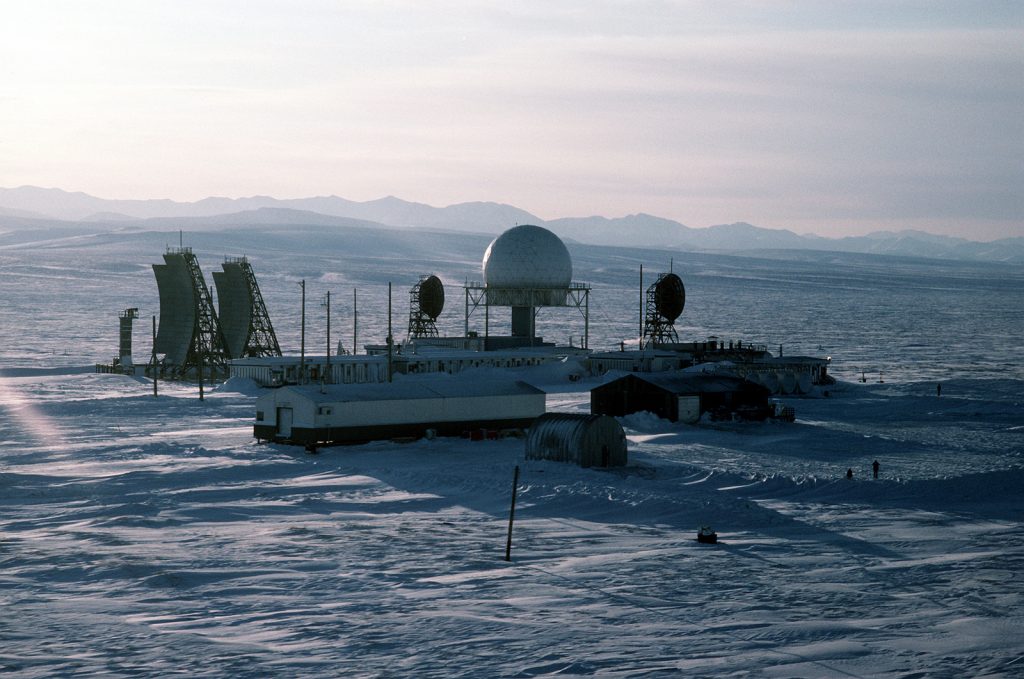On August 14, the Canadian Department of National Defense and the U.S. Department of Defense (DoD) issued a joint statement on the modernization of the North American Aerospace Defense Command (NORAD). The statement outlines the two states’ priorities for modernizing NORAD: investing in situational awareness (through upgrades to the North Warning System – NWS), improving command and control systems, conducting research and development, and developing the “capability to deter and, if necessary, defeat evolving aerospace threats to North America.”
Already suggested by U.S. General Terrence J O’Shaughnessy and U.S. Brigadier General Peter M. Fesler in their September 2020 report, the idea of a more offensive NORAD continues to gain prominence as increasing strategic competition, rapid technological advances and climate change undermine the protection provided by NORAD. Reigniting once again the debate on Canadian participation in ballistic missile defence (BMD), NORAD modernization also raises several issues. Moreover, if this joint declaration seems ambitious, it does not indicate which member state will invest in which priority. Will Canada invest in all declared priorities, or should it determine its own priorities?
Following workshops with experts of defence and security[1], this policy brief includes their perspectives on what many have called the “unwritten chapter” of Canada’s 2017 defence policy, Strong, Secure, Engaged, that is to say a chapter dealing with continental defence issues and NORAD modernization. First, Canada must position itself on the use of missile defence in NORAD modernization. Second, Canada needs to think about its strategic interests, as well as determine its priorities and threats, to choose the regions in which it wants to act. In any case, the modernization of NORAD cannot wait any longer to provide an adequate continental defence against the new threats.
NORAD Modernization: What About Missile Defence?
The North American continent has been facing weapons modernization by Canada’s and the United States’ adversaries for several years. For example, innovation in hypersonic missiles designed to penetrate North American continental defences complicates missile defence efforts. To meet these new defence challenges, NORAD’s outdated equipment makes modernization more than necessary.
There are two major components of NORAD modernization. The first component, primarily defensive in nature, consists of situational awareness and associated sensors. Considering that the current equipment for situational awareness and detection is about to become obsolete, a renovation of its equipment and the installation of new sensors will make it possible to achieve situational awareness in all domains in the near future. This component of NORAD modernization is the cornerstone of continental defence, enabling deterrence, detection, and countermeasures. The upgrade of the NWS, as well as the acquisition of new fighters and ships, for example, are part of this view of information dominance, but NORAD modernization efforts cannot be limited to upgrading Cold War-era equipment at the expense of a strategic vision more adapted to contemporary challenges.
The second component, more offensive in nature, consists of the ability to intercept missiles targeting North American territory, as well as the ability to strike the launch platforms for these missiles. The development of these capabilities implies the extension of deterrence through area denial capabilities, making continental defence more offensive. Modernizing NORAD will require both of such components to successfully counter new threats.
In face of a multitude of threats and a variety of complementary modernization avenues, what should Canada’s priorities be in modernizing NORAD? In the current international context, the debate on Canada’s participation in NORAD’s offensive capabilities is inevitable. The experts consulted are of the opinion that Canada will and should focus on the defensive side of NORAD, i.e., multi-domain threat surveillance and detection. This is especially important if there is no consensus among political elites while the public opinion is more in favour of defensive contributions. Indeed, some argue that participation in the offensive component of ballistic missile defence could make Canada too dependent on American decisions that may not be in line with Canadian values and interests. Given that Canadians are three times more likely to say that Canada should promote its values rather than its interests, and that Canada has supported strategic stability rather than BMD since the early 2000s, participation in NORAD’s offensive capabilities is more than questionable.
On the other hand, Canada may need to move towards offensive deterrence in some areas, such as cyber or air defence where the offence has the advantage, to be a credible partner in the defence against offensive threats from adversaries. This participation does not necessarily mean that Canada must host interceptor devices, but it does not necessarily rule that out either. Canada can explore both kinetic and non-kinetic roles, whether it wants to undertake an offensive mission in certain areas or focus on resilience and damage control. In other words, Canada could contribute to missile defence even if it does not directly engage in offensive neutralization mechanisms.
The Future of Canadian Defence Policy
Beyond continental defence, the question of rethinking Canada’s defence policy arises, particularly considering the reorientation of American defence strategy towards the Asia-Pacific. Canada’s defence policy suffers from a lack of strategic direction, that is, a guide to the country’s international priorities.
Canada is facing major international upheavals, including the resurgence of great power competition, and particularly the increasingly confrontational Sino-American relationship –elements that are absent from the 2017 defence policy statement. Indeed, one of the reasons for the early U.S. withdrawal from Afghanistan was to be better prepared to deal with China, which President Biden sees as the United States’ most important adversary. While Joe Biden’s goal was primarily to bring back the battered status quo under Trump, and thus rebalance the Sino-American rivalry, his fears are now that the international system is at a critical juncture that will determine the future of democracy in the world. It seems then that Biden sees the United States and other democracies as being in conflict with China and the autocracies. However, the United States is clear in its desire not to let China achieve its goals of power and influence in the world.
While the Biden administration lacks clarity, according to some, on how the U.S. will counter China, it is inevitable that the U.S. will seek support from its allies, including Canada. It is not yet clear, however, what the U.S. demands will be with respect to the Asia-Pacific. However, Canada has not traditionally played a major role in this region, focusing more on transatlantic security through contributions in Eastern Europe and the Middle East. It is also unlikely that Canada will become a major player in the Asia-Pacific, as this role is occupied by other U.S. allies. But it is to be expected that Canada will be called upon, in one way or another, to contribute to U.S. efforts against Chinese power. Canada’s contributions are uneven across issues and cannot be everywhere at once. Canada will have to make choices in the contributions it wishes to make. If, during the so-called golden age of internationalism, Canada built a reputation as a peacekeeper, it now seems to lack a strong and recognizable international identity.
Rising tensions in the Asia-Pacific are bringing back an issue that is often overlooked by this country: identifying and prioritizing threats. The 2017 defence statement is a perfect example of a defence policy without a defence strategy. The document fails to clearly identify threat actors and fails to prioritize threats. Yet, since 2017, the international context has evolved without a review of Canadian defence policy. Canada can no longer rely on the United States to defend its interests. If there is a lesson to be learned from the Trump administration, it is that the United States can become a threat to Canadian national interests. The strong partisan polarization in the U.S. risks bringing back a Donald Trump-like administration in the coming years. Therefore, without turning its back on the United States, some strategic autonomy is important for Canada. Canada will have to make choices to deal with the rise of China and Russia, as its allies. Australia, for example, has chosen to join forces with the United States and the United Kingdom in Asia-Pacific.
Perspectives of U.S. Experts
What do U.S. defence experts think? The consulted experts agree that Canada is an irreplaceable partner, particularly because of its geographic position, but that it is essential to define what threatens it. In doing so, the United States and Canada can develop a common perspective on the threats to North American security and thus decide on a more effective and coordinated joint strategy.
The influence of great power competition on the views of U.S. experts is undeniable. In the context of the U.S. pivot to the Asia-Pacific and growing strategic competition with Russia and China, the U.S. perceive Canada as a reliable ally, but one that is somewhat lax in prioritizing and identifying its strategic interests. This is necessarily problematic in the face of assertive U.S. positions.
U.S. experts therefore want not only more clarity, but also more openness from Canada. The importance of Canada’s commitment to modernizing NORAD is seen as being matched by an openness to new sensor technologies and infrastructure. However, there is no consensus on Canada’s participation in missile defence – particularly in BMD – because of its limited scope in the context of great power competition. According to some, priority should be given to situational awareness, especially given the critical state of the NWS in the Arctic.
At the diplomatic level, U.S. experts believe that Canada has a very powerful voice, especially when combined with that of the United States. The influence of a unified Canadian and American voice in the Arctic is not to be overlooked. While both countries must deal with the limits of their national sovereignty, it is in their best interest to work together. An alignment of Canadian and U.S. positions on Arctic and Asia-Pacific issues would clearly be the best option for both countries.
Recommendations
In all cases, Canada must clearly identify and prioritize the issues and actors that pose a threat. This identification and prioritization will allow Canada to target the contributions it can make according to their importance to Canadian interests, but also to the expectations of allies. While Canada has long been divided between its atlanticist (NATO), continentalist (United States) and internationalist (UN) positions, should we now prioritize the Arctic, the Asia-Pacific, or another region of the world more specifically? It is in Canada’s interest to refine its positions and to be less scattered among its various international postures. In fact, Canada can no longer afford to sprinkle its capabilities in all regions of the world: it must focus on regions in which it has priority strategic interests. Canada cannot afford to be totally independent of its allies. Canada must therefore prioritize partnerships that support Canada’s chosen path, whatever that may be.
As a sovereign state, Canada must in some way prioritize the Arctic, given its strategic importance, and that means having a presence in the North. Whether it is through military forces, economic development, service delivery, indigenous peoples, climate change or national defence, Canada must be concerned about the Arctic. Modernizing the NWS, in this sense, is a priority. Therefore, Canada should not participate in the offensive component of the missile defence shield soon, but rather invest its time, funds and expertise in surveillance and threat detection technologies, particularly in the Arctic, as the United States already relies on Canada’s assistance in this area –which is not the case with the BMD.
In the Asia-Pacific, Canada must find a way to contribute to developments in the region with the limited capabilities of a middle power. This could involve strengthening Canada’s diplomatic presence and increasing partnerships with regional allies. Canada can build a reputation in the region without getting involved militarily. Canada can remain a secondary player in the Asia-Pacific.
As a middle power, Canada cannot afford to have a significant presence everywhere. It must choose its contributions carefully, where it can add value. To do this, Canada must not be satisfied with small contributions everywhere, but rather target priority regions or issues. It is therefore imperative to think about concentrating resources on niche areas where Canada has proven expertise, such as peacekeeping during the Cold War. This could be capacity building and military training in Asia and Africa, or natural disaster response capabilities. Cyberspace could also be an interesting niche, in cooperation with Eastern European countries, provided sufficient resources are available. However, there are two constraints to focusing on niche areas. The first is to find a niche with symbolic power that can offer international influence on Canada and unite Canadians. The second constraint is that there is a danger in choosing a niche: a country with more resources could make Canada invisible in this area. Thus, niches work best when they derive naturally from a particular recognized state’s experience and expertise. [2]
With respect to Canada’s alignment with the United States, it is very difficult to imagine that Canadian positions are not at least minimally aligned with those of the DoD, especially with respect to NORAD. However, Canada can no longer afford to be a free rider. Canada’s relationship with the United States must be problematized. This is not to say that the United States is no longer Canada’s first and most important ally. Rather, it is about realizing and accepting that the United States no longer necessarily sees Canada as its primary ally. The experience of Donald Trump’s mandate as President has shown how the United States can also pose a significant threat to Canada’s interests. A possible return to political instability is not to be overlooked with our neighbours to the south.
With threats to the security of North America and a volatile international environment, Canada, like the United States, can no longer afford to put off modernizing NORAD: the time to act is now. The modernization of NORAD and the NWS is on the platforms of both the Liberal and Conservative Parties of Canada, demonstrating a consensus on the defensive modernization of NORAD. However, with no public debate planned on this modernization and with little detail provided by the parties on the substance and form of this modernization, the NORAD issue is likely to make waves among the Canadian population when the nature and real price of this inevitable modernization is finally known.
[1] The first workshop on June 17, 2021 brought together Jonathan Paquin from Laval University, Stéphane Roussel from École nationale d’Administration publique, Gaëlle Rivard Piché from Defence Research and Development Canada, Yann Breault from Royal Military College of St-Jean, Laurent Borzillo from University of Quebec in Montreal, Chantal Lavallée from Royal Military College of St-Jean, Nancy Teeple from Defence Research and Development Canada, Pauline Pic from Laval University, Pierre Colautti from Laval University, Stéfanie von Hlatky from Queen’s University, Justin Massie from the University of Quebec in Montreal, Marco Munier from the University of Quebec in Montreal and Camille Raymond from the University of Quebec in Montreal. The second workshop on July 7 featured Christopher Sands of the Johns Hopkins University School of Advanced International Studies; Anessa Kimball of Laval University; Major General (ret.) Randy “Church” Kee of the Wilson Center and the University of Alaska; Jack David formerly of the U.S. Permanent Joint Board on Defense; and Ian Williams of the Center for Strategic and International Studies.
[2] We wish to thank Adam Chapnick for this remark.






Comments are closed.